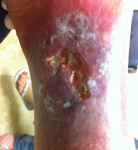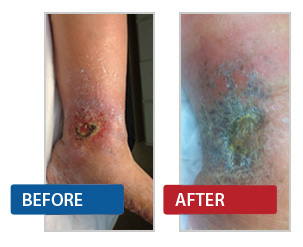Leg Wound
What are venous ulcers?
Venous leg ulcers are by far the most common form of ulcers affecting the lower extremities. Venous Leg ulcers represent a severe form of venous disease and may be the end-stage of chronic venous insufficiency. Venous leg ulcers occur most commonly at the ankles.
Venous Leg Ulcer can have a very significant impact on quality of life, with major disability and social impairment. Since this is a condition that often doesn’t heal without treatment, it tends to be chronic, frequently relapses, and thus causes massive health care expenditures
Symptoms of Venous Leg Ulcers:
Venous ulcers typically start as areas of dark, reddish-brown skin that are hard and feel warm to the touch. The area may be very painful and may itch continuously. White scar tissue may also develop in the area as well causing a sore leg.
Treatment of Venous leg ulcers:
Venous leg ulcers must be treated appropriately by a vein specialist (phlebologist). Diagnostic testing will help to determine the particular pattern of diseased veins causing the problem. Treatment will typically involve attempts to reduce the swelling and wound cure for leg ulcers in the affected area and the pressure in the veins.
In severe cases of venous leg ulcers, a skin graft to replace damaged tissue may be warranted. Venous ulcers are usually caused by varicose veins and chronic venous insufficiency and may occur after the above conditions have existed for some time.
Venous reflux (or valve failure) or other vein conditions can lead to the pooling of blood, causing venous hypertension (increased pressures in the veins of the lower leg). This may come from more superficial veins (like varicose veins), deeper veins (related to deep vein thrombosis or DVT), or perforator veins, which connect the veins of the superficial and deep vein systems.
When these high-pressure conditions exist, fluid can leak out into the surrounding tissues, and inflammation of the tissues occurs leading to impairment of normal transfer of nutrients and oxygen to the tissues.

Venous ulcer 1

Venous ulcer 2
Managing Leg Ulcers and Wounds in Diabetic Patients:
Diabetic patients are at a higher risk of developing leg ulcers due to poor circulation and nerve damage caused by elevated blood sugar levels. Seeking professional help for a diabetic wound or ulcers is also crucial, as these wounds can be particularly challenging to heal due to the effects of diabetes on the body’s healing processes.
Ulcers can result from minor scrapes or cuts that don’t heal properly, often exacerbated by diabetic neuropathy, which reduces sensation in the feet. It’s important to consult with healthcare professionals who specialize in diabetic wound care.
Compression Therapy for Venous Ulcer:
Possible treatments of venous leg ulcers often include wound dressings, compression stockings or bandages, varicose vein treatments (e.g., endovenous laser treatment), and/or a special cast-like boot (called an ‘Unna boot’).
Over time, the diminished level of nutrients and oxygen and the inflammation created causes damage to the surrounding tissues, which can result in skin discoloration and tissue death.



